在 第 14.3 节-第 14.8 节讨论对象检测任务时,矩形边界框用于标记和预测图像中的对象。本节将讨论语义分割问题,重点关注如何将图像划分为属于不同语义类的区域。与目标检测不同,语义分割在像素级别识别和理解图像中的内容:它对语义区域的标记和预测是在像素级别。 图 14.9.1显示了语义分割中图像的狗、猫和背景的标签。与目标检测相比,语义分割中标记的像素级边界明显更细粒度。
图 14.9.1语义分割中图像的狗、猫和背景的标签。
14.9.1。图像分割和实例分割
计算机视觉领域还有两个与语义分割类似的重要任务,即图像分割和实例分割。我们将如下简要地将它们与语义分割区分开来。
图像分割将图像分成几个组成区域。这类问题的方法通常利用图像中像素之间的相关性。它在训练时不需要图像像素的标签信息,也不能保证分割后的区域在预测时具有我们希望得到的语义。以图 14.9.1中的图像 作为输入,图像分割可以将狗分成两个区域:一个覆盖以黑色为主的嘴巴和眼睛,另一个覆盖以黄色为主的身体其余部分。
实例分割也称为同时检测和分割。它研究如何识别图像中每个对象实例的像素级区域。与语义分割不同,实例分割不仅需要区分语义,还需要区分不同的对象实例。例如,如果图像中有两只狗,实例分割需要区分一个像素属于这两只狗中的哪一只。
14.9.2。Pascal VOC2012 语义分割数据集
最重要的语义分割数据集之一是Pascal VOC2012。下面,我们将看看这个数据集。
%matplotlib inline import os import torch import torchvision from d2l import torch as d2l
%matplotlib inline import os from mxnet import gluon, image, np, npx from d2l import mxnet as d2l npx.set_np()
数据集的 tar 文件大约 2 GB,因此下载文件可能需要一段时间。提取的数据集位于 ../data/VOCdevkit/VOC2012.
#@save d2l.DATA_HUB['voc2012'] = (d2l.DATA_URL + 'VOCtrainval_11-May-2012.tar', '4e443f8a2eca6b1dac8a6c57641b67dd40621a49') voc_dir = d2l.download_extract('voc2012', 'VOCdevkit/VOC2012')
Downloading ../data/VOCtrainval_11-May-2012.tar from http://d2l-data.s3-accelerate.amazonaws.com/VOCtrainval_11-May-2012.tar...
#@save
d2l.DATA_HUB['voc2012'] = (d2l.DATA_URL + 'VOCtrainval_11-May-2012.tar',
'4e443f8a2eca6b1dac8a6c57641b67dd40621a49')
voc_dir = d2l.download_extract('voc2012', 'VOCdevkit/VOC2012')
进入路径后../data/VOCdevkit/VOC2012,我们可以看到数据集的不同组成部分。该ImageSets/Segmentation路径包含指定训练和测试样本的文本文件,而 JPEGImages和SegmentationClass路径分别存储每个示例的输入图像和标签。这里的label也是image格式的,和它的labeled input image大小一样。此外,任何标签图像中具有相同颜色的像素属于同一语义类。下面定义了read_voc_images将所有输入图像和标签读入内存的函数。
#@save
def read_voc_images(voc_dir, is_train=True):
"""Read all VOC feature and label images."""
txt_fname = os.path.join(voc_dir, 'ImageSets', 'Segmentation',
'train.txt' if is_train else 'val.txt')
mode = torchvision.io.image.ImageReadMode.RGB
with open(txt_fname, 'r') as f:
images = f.read().split()
features, labels = [], []
for i, fname in enumerate(images):
features.append(torchvision.io.read_image(os.path.join(
voc_dir, 'JPEGImages', f'{fname}.jpg')))
labels.append(torchvision.io.read_image(os.path.join(
voc_dir, 'SegmentationClass' ,f'{fname}.png'), mode))
return features, labels
train_features, train_labels = read_voc_images(voc_dir, True)
#@save
def read_voc_images(voc_dir, is_train=True):
"""Read all VOC feature and label images."""
txt_fname = os.path.join(voc_dir, 'ImageSets', 'Segmentation',
'train.txt' if is_train else 'val.txt')
with open(txt_fname, 'r') as f:
images = f.read().split()
features, labels = [], []
for i, fname in enumerate(images):
features.append(image.imread(os.path.join(
voc_dir, 'JPEGImages', f'{fname}.jpg')))
labels.append(image.imread(os.path.join(
voc_dir, 'SegmentationClass', f'{fname}.png')))
return features, labels
train_features, train_labels = read_voc_images(voc_dir, True)
我们绘制前五个输入图像及其标签。在标签图像中,白色和黑色分别代表边框和背景,而其他颜色对应不同的类别。
n = 5 imgs = train_features[:n] + train_labels[:n] imgs = [img.permute(1,2,0) for img in imgs] d2l.show_images(imgs, 2, n);
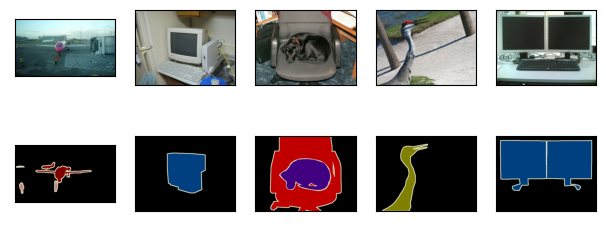
n = 5 imgs = train_features[:n] + train_labels[:n] d2l.show_images(imgs, 2, n);

接下来,我们枚举该数据集中所有标签的 RGB 颜色值和类名。
#@save
VOC_COLORMAP = [[0, 0, 0], [128, 0, 0], [0, 128, 0], [128, 128, 0],
[0, 0, 128], [128, 0, 128], [0, 128, 128], [128, 128, 128],
[64, 0, 0], [192, 0, 0], [64, 128, 0], [192, 128, 0],
[64, 0, 128], [192, 0, 128], [64, 128, 128], [192, 128, 128],
[0, 64, 0], [128, 64, 0], [0, 192, 0], [128, 192, 0],
[0, 64, 128]]
#@save
VOC_CLASSES = ['background', 'aeroplane', 'bicycle', 'bird', 'boat',
'bottle', 'bus', 'car', 'cat', 'chair', 'cow',
'diningtable', 'dog', 'horse', 'motorbike', 'person',
'potted plant', 'sheep', 'sofa', 'train', 'tv/monitor']
#@save
VOC_COLORMAP = [[0, 0, 0], [128, 0, 0], [0, 128, 0], [128, 128, 0],
[0, 0, 128], [128, 0, 128], [0, 128, 128], [128, 128, 128],
[64, 0, 0], [192, 0, 0], [64, 128, 0], [192, 128, 0],
[64, 0, 128], [192, 0, 128], [64, 128, 128], [192, 128, 128],
[0, 64, 0], [128, 64, 0], [0, 192, 0], [128, 192, 0],
[0, 64, 128]]
#@save
VOC_CLASSES = ['background', 'aeroplane', 'bicycle', 'bird', 'boat',
'bottle', 'bus', 'car', 'cat', 'chair', 'cow',
'diningtable', 'dog', 'horse', 'motorbike', 'person',
'potted plant', 'sheep', 'sofa', 'train', 'tv/monitor']
使用上面定义的两个常量,我们可以方便地找到标签中每个像素的类索引。我们定义了voc_colormap2label 构建从上述 RGB 颜色值到类索引的映射的函数,以及voc_label_indices将任何 RGB 值映射到此 Pascal VOC2012 数据集中它们的类索引的函数。
#@save def voc_colormap2label(): """Build the mapping from RGB to class indices for VOC labels.""" colormap2label = torch.zeros(256 ** 3, dtype=torch.long) for i, colormap in enumerate(VOC_COLORMAP): colormap2label[ (colormap[0] * 256 + colormap[1]) * 256 + colormap[2]] = i return colormap2label #@save def voc_label_indices(colormap, colormap2label): """Map any RGB values in VOC labels to their class indices.""" colormap = colormap.permute(1, 2, 0).numpy().astype('int32') idx = ((colormap[:, :, 0] * 256 + colormap[:, :, 1]) * 256 + colormap[:, :, 2]) return colormap2label[idx]
#@save
def voc_colormap2label():
"""Build the mapping from RGB to class indices for VOC labels."""
colormap2label = np.zeros(256 ** 3)
for i, colormap in enumerate(VOC_COLORMAP):
colormap2label[
(colormap[0] * 256 + colormap[1]) * 256 + colormap[2]] = i
return colormap2label
#@save
def voc_label_indices(colormap, colormap2label):
"""Map any RGB values in VOC labels to their class indices."""
colormap = colormap.astype(np.int32)
idx = ((colormap[:, :, 0] * 256 + colormap[:, :, 1]) * 256
+ colormap[:, :, 2])
return colormap2label[idx]
例如,在第一个示例图像中,飞机前部的类别索引为 1,而背景索引为 0。
y = voc_label_indices(train_labels[0], voc_colormap2label()) y[105:115, 130:140], VOC_CLASSES[1]
(tensor([[0, 0, 0, 0, 0, 0, 0, 0, 0, 1],
[0, 0, 0, 0, 0, 0, 0, 1, 1, 1],
[0, 0, 0, 0, 0, 0, 1, 1, 1, 1],
[0, 0, 0, 0, 0, 1, 1, 1, 1, 1],
[0, 0, 0, 0, 0, 1, 1, 1, 1, 1],
[0, 0, 0, 0, 1, 1, 1, 1, 1, 1],
[0, 0, 0, 0, 0, 1, 1, 1, 1, 1],
[0, 0, 0, 0, 0, 1, 1, 1, 1, 1],
[0, 0, 0, 0, 0, 0, 1, 1, 1, 1],
[0, 0, 0, 0, 0, 0, 0, 0, 1, 1]]),
'aeroplane')
y = voc_label_indices(train_labels[0], voc_colormap2label()) y[105:115, 130:140], VOC_CLASSES[1]
(array([[0., 0., 0., 0., 0., 0., 0., 0., 0., 1.],
[0., 0., 0., 0., 0., 0., 0., 1., 1., 1.],
[0., 0., 0., 0., 0., 0., 1., 1., 1., 1.],
[0., 0., 0., 0., 0., 1., 1., 1., 1., 1.],
[0., 0., 0., 0., 0., 1., 1., 1., 1., 1.],
[0., 0., 0., 0., 1., 1., 1., 1., 1., 1.],
[0., 0., 0., 0., 0., 1., 1., 1., 1., 1.],
[0., 0., 0., 0., 0., 1., 1., 1., 1., 1.],
[0., 0., 0., 0., 0., 0., 1., 1., 1., 1.],
[0., 0., 0., 0., 0., 0., 0., 0., 1., 1.]]),
'aeroplane')
14.9.2.1。数据预处理
在之前的实验中,例如 第 8.1 节-第 8.4 节中,图像被重新缩放以适应模型所需的输入形状。然而,在语义分割中,这样做需要将预测的像素类重新缩放回输入图像的原始形状。这种重新缩放可能不准确,尤其是对于具有不同类别的分段区域。为避免此问题,我们将图像裁剪为固定形状而不是重新缩放。具体来说,使用图像增强的随机裁剪,我们裁剪输入图像和标签的相同区域。
#@save def voc_rand_crop(feature, label, height, width): """Randomly crop both feature and label images.""" rect = torchvision.transforms.RandomCrop.get_params( feature, (height, width)) feature = torchvision.transforms.functional.crop(feature, *rect) label = torchvision.transforms.functional.crop(label, *rect) return feature, label imgs = [] for _ in range(n): imgs += voc_rand_crop(train_features[0], train_labels[0], 200, 300) imgs = [img.permute(1, 2, 0) for img in imgs] d2l.show_images(imgs[::2] + imgs[1::2], 2, n);
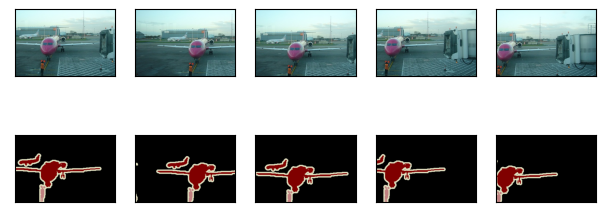
#@save def voc_rand_crop(feature, label, height, width): """Randomly crop both feature and label images.""" feature, rect = image.random_crop(feature, (width, height)) label = image.fixed_crop(label, *rect) return feature, label imgs = [] for _ in range(n): imgs += voc_rand_crop(train_features[0], train_labels[0], 200, 300) d2l.show_images(imgs[::2] + imgs[1::2], 2, n);

14.9.2.2。自定义语义分割数据集类
VOCSegDataset 我们通过继承Dataset高级 API 提供的类来定义自定义语义分割数据集类。通过实现该__getitem__函数,我们可以任意访问数据集中索引的输入图像idx以及该图像中每个像素的类索引。由于数据集中的某些图像的尺寸小于随机裁剪的输出尺寸,因此这些示例被自定义函数过滤掉filter。此外,我们还定义了normalize_image函数来标准化输入图像的三个 RGB 通道的值。
#@save
class VOCSegDataset(torch.utils.data.Dataset):
"""A customized dataset to load the VOC dataset."""
def __init__(self, is_train, crop_size, voc_dir):
self.transform = torchvision.transforms.Normalize(
mean=[0.485, 0.456, 0.406], std=[0.229, 0.224, 0.225])
self.crop_size = crop_size
features, labels = read_voc_images(voc_dir, is_train=is_train)
self.features = [self.normalize_image(feature)
for feature in self.filter(features)]
self.labels = self.filter(labels)
self.colormap2label = voc_colormap2label()
print('read ' + str(len(self.features)) + ' examples')
def normalize_image(self, img):
return self.transform(img.float() / 255)
def filter(self, imgs):
return [img for img in imgs if (
img.shape[1] >= self.crop_size[0] and
img.shape[2] >= self.crop_size[1])]
def __getitem__(self, idx):
feature, label = voc_rand_crop(self.features[idx], self.labels[idx],
*self.crop_size)
return (feature, voc_label_indices(label, self.colormap2label))
def __len__(self):
return len(self.features)
#@save
class VOCSegDataset(gluon.data.Dataset):
"""A customized dataset to load the VOC dataset."""
def __init__(self, is_train, crop_size, voc_dir):
self.rgb_mean = np.array([0.485, 0.456, 0.406])
self.rgb_std = np.array([0.229, 0.224, 0.225])
self.crop_size = crop_size
features, labels = read_voc_images(voc_dir, is_train=is_train)
self.features = [self.normalize_image(feature)
for feature in self.filter(features)]
self.labels = self.filter(labels)
self.colormap2label = voc_colormap2label()
print('read ' + str(len(self.features)) + ' examples')
def normalize_image(self, img):
return (img.astype('float32') / 255 - self.rgb_mean) / self.rgb_std
def filter(self, imgs):
return [img for img in imgs if (
img.shape[0] >= self.crop_size[0] and
img.shape[1] >= self.crop_size[1])]
def __getitem__(self, idx):
feature, label = voc_rand_crop(self.features[idx], self.labels[idx],
*self.crop_size)
return (feature.transpose(2, 0, 1),
voc_label_indices(label, self.colormap2label))
def __len__(self):
return len(self.features)
14.9.2.3。读取数据集
我们使用自定义VOCSegDataset 类分别创建训练集和测试集的实例。假设我们指定随机裁剪图像的输出形状是320×480. 下面我们可以查看训练集和测试集中保留的示例数量。
crop_size = (320, 480) voc_train = VOCSegDataset(True, crop_size, voc_dir) voc_test = VOCSegDataset(False, crop_size, voc_dir)
read 1114 examples read 1078 examples
crop_size = (320, 480) voc_train = VOCSegDataset(True, crop_size, voc_dir) voc_test = VOCSegDataset(False, crop_size, voc_dir)
read 1114 examples read 1078 examples
将批量大小设置为 64,我们为训练集定义数据迭代器。让我们打印第一个小批量的形状。与图像分类或目标检测不同,这里的标签是三维张量。
batch_size = 64
train_iter = torch.utils.data.DataLoader(voc_train, batch_size, shuffle=True,
drop_last=True,
num_workers=d2l.get_dataloader_workers())
for X, Y in train_iter:
print(X.shape)
print(Y.shape)
break
torch.Size([64, 3, 320, 480]) torch.Size([64, 320, 480])
batch_size = 64
train_iter = gluon.data.DataLoader(voc_train, batch_size, shuffle=True,
last_batch='discard',
num_workers=d2l.get_dataloader_workers())
for X, Y in train_iter:
print(X.shape)
print(Y.shape)
break
(64, 3, 320, 480) (64, 320, 480)
14.9.2.4。把它们放在一起
最后,我们定义以下load_data_voc函数来下载和读取 Pascal VOC2012 语义分割数据集。它返回训练和测试数据集的数据迭代器。
#@save
def load_data_voc(batch_size, crop_size):
"""Load the VOC semantic segmentation dataset."""
voc_dir = d2l.download_extract('voc2012', os.path.join(
'VOCdevkit', 'VOC2012'))
num_workers = d2l.get_dataloader_workers()
train_iter = torch.utils.data.DataLoader(
VOCSegDataset(True, crop_size, voc_dir), batch_size,
shuffle=True, drop_last=True, num_workers=num_workers)
test_iter = torch.utils.data.DataLoader(
VOCSegDataset(False, crop_size, voc_dir), batch_size,
drop_last=True, num_workers=num_workers)
return train_iter, test_iter
#@save
def load_data_voc(batch_size, crop_size):
"""Load the VOC semantic segmentation dataset."""
voc_dir = d2l.download_extract('voc2012', os.path.join(
'VOCdevkit', 'VOC2012'))
num_workers = d2l.get_dataloader_workers()
train_iter = gluon.data.DataLoader(
VOCSegDataset(True, crop_size, voc_dir), batch_size,
shuffle=True, last_batch='discard', num_workers=num_workers)
test_iter = gluon.data.DataLoader(
VOCSegDataset(False, crop_size, voc_dir), batch_size,
last_batch='discard', num_workers=num_workers)
return train_iter, test_iter
14.9.3。概括
语义分割通过将图像划分为属于不同语义类的区域,以像素级别识别和理解图像中的内容。
最重要的语义分割数据集之一是 Pascal VOC2012。
在语义分割中,由于输入图像和标签在像素上一一对应,输入图像被随机裁剪成固定形状而不是重新缩放。
14.9.4。练习
语义分割如何应用于自动驾驶汽车和医学图像诊断?你能想到其他应用吗?
回想一下14.1 节中对数据扩充的描述 。图像分类中使用的哪种图像增强方法不能应用于语义分割?
-
数据集
+关注
关注
4文章
1230浏览量
26046 -
pytorch
+关注
关注
2文章
813浏览量
14698
发布评论请先 登录
几大主流公开遥感数据集
广泛应用的城市语义分割的数据集整理
DeepLab进行语义分割的研究分析

大华股份AI刷新了Cityscapes数据集中语义分割任务的全球最好成绩
分析总结基于深度神经网络的图像语义分割方法






 PyTorch教程-14.9. 语义分割和数据集
PyTorch教程-14.9. 语义分割和数据集

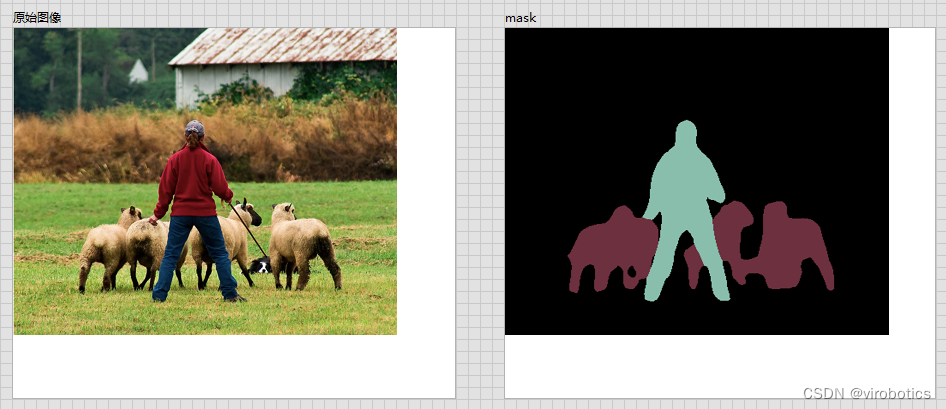

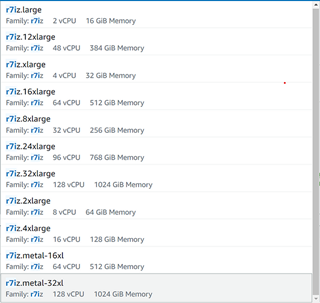
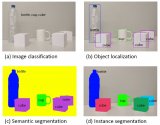










评论